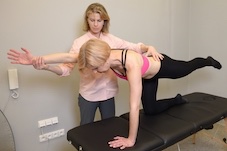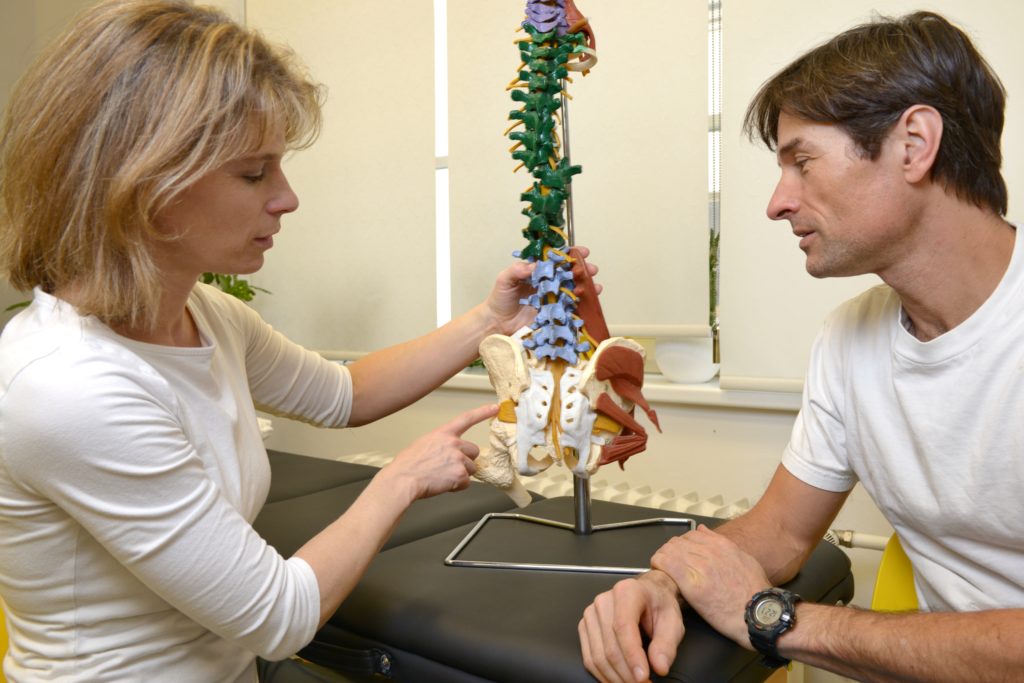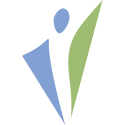Prevalence of back pain

According to data published by World Health Organization back pain affects people of all ages, from children to the elderly, and is a very frequent reason for medical consultations. The lifetime prevalence of non-specific (common) low back pain is estimated at 60% to 70% in industrialized countries. Very rarely the cause of back pain is addressed and it is often treated just by analgesics. Surgery is indicated in some cases and remains last option. Physical therapy offers conservative approach that is often very effective and safe.
Common causes
Back pain can range from mild to severe. It can be one of the most limiting to your mobility and overall sense of wellbeing. It is caused by various reasons. Age of a person suffering back pain and mechanism of injury determine the diagnosis and appropriate treatment.
Common mechanisms of back injury
- Bad posture, prolonged sitting
- Repetitive motion in one direction (bending, extending or rotation, sometimes repeated combination of movements)
- Heavy lifting
- Falls
- Pregnancy
- Obesity
- Insufficient sleep
- Depression
Postural syndrome
Have you seen a teenager using smartphone? Of course, every teenager has one. Just observe the posture of people using smartphone. Array of postures can be seen, from slouched to curled up, tilted or twisted. Summed up with the static, usually slouched postures at school, the postural system is calling for “help”. Imagine holding in apple in your outstretched arm. At first, it is easy, the apple is light. Nevertheless, after 5 minutes your arm will start to ache, your body will tell you “stop” this is too difficult, “put the arm down”. If you continue to hold the apple in the same position, the pain will reach a level that you cannot ignore and your arm will “fall down”.
Pain is an information from the postural musculature, it is impossible to ignore, but it does not mean tissue damage, it simply means the muscles are overworked.
Postural back pain in teenagers and young adults is very common. There is usually nothing to be found on x-ray or MRI, yet the pain is very real and nagging. Postural back pain very quickly goes away as soon as the individual moves. Postural correction and maintaining neutral static positions can abolish postural pain. Taping with an elastic tape helps to correct posture and acts as a remainder to stay in correct posture. Postural back pain is more common in kids and teenagers, but can affect anyone.
Disc prolapse
Discs are structures providing cushioning between your vertebrae. They consist of nucleus in the middle and annulus that surrounds the nucleus. One of the most common injuries to the disc is herniation. It means that the nucleus is mechanically pushed to through the annulus to the edge of the disc. Once the nucleus touches the edge of the disc, the person starts to experience pain. Sometimes the nucleus can push through the edge of the annulus resulting in a prolapsed disc. Prolapsed disc can cause array of symptoms. Pain, tingling or even numbness can be one of them. Pain is the most common symptoms and it can radiate down into the buttock or even leg. Some herniated disc are indication for surgery, especially if there is weakness in the lower extremity. However, most of the injuries can be reversed by mechanical therapy (positioning and exercise).
Chronic Back pain
Back pain becomes chronic if it lasts longer than 12 weeks despite treatment. If this is the case, movement is the key component of treatment. Walking, jogging, biking, swimming, dancing or playing sports will reduce pain and improve quality of live. To reduce back pain, engage in your favorite kind of exercise for at least 40 minutes daily. Remember, all activity counts, even 10 minutes here and there. However, exercising continually for 40 minutes will be most beneficial for pain relief. Our bodies have an amazing ability to heal and you too will be pain-free. Your physical therapist can help you learn how your body responds to movement and what activity to focus on. Postural correction combined with targeted strengthening of your core musculature as well as mechanical therapy will help. Please click on this link to learn more about chronic pain research by Lorimer Moseley.
Back pain during Pregnancy
Hormonal changes
During pregnancy the mechanics of the body changes due to couple of factors. Pregnancy hormone relaxin is produced by ovaries and the placenta, in preparation for childbirth. Relaxin relaxes the ligaments in the pelvis and softens and widens the cervix. Relaxin reaches its peak in the first trimester and near the delivery. The hormone remains in the mother’s body for up to five months after delivery. The effect on ligaments in women’s pelvis can lead to a very common pain in the lower back that comes from instability of the sacroiliac joints. The pain can be mild to crippling preventing the person from weight bearing on one side or having difficulty with rolling over in bed or getting in and out of a car. Sacroiliac belt and manual therapy can relieve this pain. Avoidance of leg crossing, excessive stretching of the hips and performing exercises with weight on legs is distributed unevenly helps to prevent the sacroiliac joint pain.
Balance
The other factor in pregnancy back pain is shift in the center of gravity in the last trimester. This has an effect on the woman’s balance and posture. Pain in the small of the back is usually central and stops with lying down. This pain can be relieved by posterior pelvic tilt, or tucking in the tailbone under. Wide pregnancy belts also help to support lower back.
Obesity and back pain
Being overweight or obese increases risk for back pain. The excess weight that is carried by an obese person puts additional strain and pressure on the spine. However, loosing weight is not an overnight matter and it has to happen gradually. There are certainly ways to reduce back pain when overweight. Physiotherapy evaluation is needed to diagnose the root of the pain and start mechanical therapy that is effective and allows the person to be in control. It is very difficulty to exercise to loose weight when having back pain. Good way to start both weight loss and exercises is aquatic therapy, swimming or just plain walking in the water. Your therapist can guide you to choose the appropriate exercises and help you to get started.
První pomoc při bolestech zad – co dělat doma
Acute back pain
If you back pain is not manageable and reaches level 8/10 or more we recommend you visit a doctor to reduce your back pain. If you can find a position that reduces your pain, and you can manage to move, you can start working with a physiotherapist.
You can try a position in prone with couple of pillows under your abdomen and progress to laying flat on your stomach. You can use ice or heat to reduce the pain. Avoid painful positions and movements. Contact your doctor if pain is bad, start working with a therapist as soon as possible.
When to contact your doctor if you experience the following:
- Wake up at night because of pain, this can be sign of bone infection, pain is constant
- Have severe pain that is associated with numbness in your “saddle” area
- Severe back pain and fever
- Incontinence of urine and stools
- Have a history of cancer
- Have progressively worsening pain after trauma
Back pain treatment
The most important factor is to stay active, do not stop moving. Practice avoidance of pain. After your evaluation your therapist will introduce home program and explain why and how often you should perform these exercises. Call your physical therapist to schedule an appointment as soon as possible.(Contact) or schedule an appointment Online on the web.
Sleep
Lack of sleep can cause back pain, back pain can cause insomnia. To break this vicious cycle, it is important to bear in mind two factors.
- The length of sleep should be 8-9 hours
- Regular sleep schedule is essential (go to bed and wake up at the same time, there is no possibility to “catch up on your sleep”)
Sleep is essential for our body to recover. Allowing your body to rest will help your recovery.
Position for good sleep
Sleeping positions depend on your comfort. The easiest is lying on your side with a pillow between your knees and ankles for support. This is especially important for pregnant women and when you are experiencing sciatic pain. The position you fall asleep is the only one you can control during your sleep. Your mattress should not be sagging. If you feel your mattress is the cause of your back pain, try sleeping in another bed in your house before buying a new bed. Most likely new mattress will not “fix” your back pain. Quite the contrary. We often have to get used to the new mattress and it can take several days for us to feel we are well rested.
What to expect at your Physiotherapy visit
Subjective evaluation
Your physical therapist will ask you the mechanism of injury if known. She or he will want to know when the pain started and if there was certain position or movement that may have caused it. All the information you can give is helpful:
- Where is your pain/ numbness/ tingling or sensation of weakness right now?
- Is there pain-relieving position or movement?
- Is there position or movement that make you feel worse? Is your pain constant?
- Is your pain worse in the morning or at night or as the day progresses?
- Have you experienced this kind of pain before?
- Is the pain improving/ staying the same/ getting worse?
Objective evaluation
Your therapist will ask you to move your back in certain directions according to the history, your age, location and severity of the pain. She will check your sensation, strength and range of motion in your back and hips.
Mechanical therapy
Mechanical therapy uses motion to treat the injured area. In most cases it is the best treatment option. It improves circulation, reduces pain and helps you to recover fast. Your therapist will recommend a particular exercises depending on the history and evaluation. She will explain the mechanism of injury and the best treatment. You will work as a team to determine to which direction to move to reduce pain or get rid of your symptoms.
Home exercise program
You will be asked to perform the exercises frequently at home to continue to reduce your symptoms. Mechanical therapy works best if you keep doing it throughout the day. Sometimes the prescription for exercises calls for performing the exercises every waking hour. You may be asked to avoid certain positions and movements for several days. You will be instructed in the home program and you will obtain videos or pictures of the exercises you should do.
Taping
In the last three decades kinesiotaping has been used widely to complement other treatments. Both, elastic and rigid taping is an excellent way to improve postural syndrome and relieve pain. If you find taping helpful, your therapist can instruct you how to tape yourself. Any tape should not be worn for more than 1-3 consecutive days. After that your skin will need several hours of rest. Should you develop sensitivity to the tape (redness or itching), remove the tape immediately. You can shower with the tape and just pat dry it after shower. To remove the tape it is recommended to use oil or wet the tape and peel it slowly while supporting the skin.
Modalities
In addition to mechanical therapy, modalities to reduce pain are useful, such as ice, heat, electrical stimulation or massage. However, these have only temporary effect and are not curative.
Nobody should suffer with back pain young or old, thin or overweight. Physical therapy is safe, effective and non-invasive way to treat your back pain.

